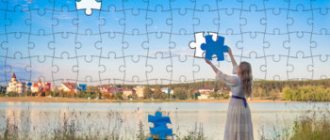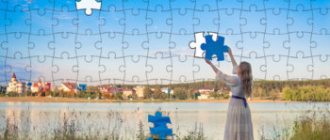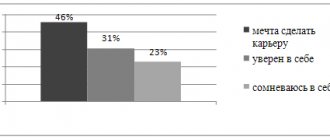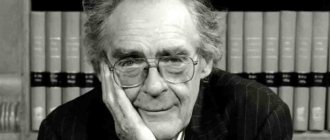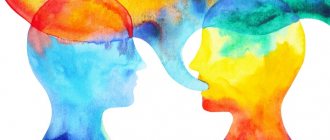Imagination is the process of creating new images of the future, based on previous experiences and creative thinking. It plays an important role in creating images that were not accepted by a person in reality, influences the strength of emotions and feelings, and is an important factor in the development of human personality.
“ “Imagination is a necessary and integral moment of thinking, since thinking always includes the processes of forecasting and anticipation.” L.S. Vygotsky
It tends to develop under the influence of broadening one’s horizons, accumulating experience, images and information. Attention has been paid to the development of imagination since childhood; many children's games and exercises in preschool and secondary educational institutions are aimed at it.
Another property of imagination is that it is not constant, periods of decline alternate with rises, so-called inspiration, but it has been scientifically proven that inspiration and fresh ideas often come to us precisely in the process of work, after a certain amount of effort.
Classifications
By degree of activity:
- Active (stimulates the implementation of created images, activates creative activity, sometimes requires great effort if the creation of images is necessary for work, for example, like writers, screenwriters, decorators).
- Passive (does not encourage a person to take active action, but only generates images in his mind with which he is satisfied without realizing them, or they are, in principle, not realizable).
By type:
- Productive (creates new elements, so-called fantasy products, something that did not previously exist).
- Reproductive (imagination based on existing phenomena and objects).
- Dreams (the process of imagination aimed at the real future).
- Hallucinations (images created by altered consciousness).
- Dreams.
In connection with past experience:
- Recreating (imagination that is based on experience).
- Creative (creating new images with minimal reliance on experience)
Basic Concepts
Imagination is not only a tool of a creative person.
It is valuable for a representative of any profession, because it allows you to think creatively and go beyond standard ideas.
Fantasy makes it possible not only to create from scratch, but also to imagine images and diagrams without errors in the process of reading scientific and fiction literature, to solve problems directly related to the use of visual-figurative thinking, to plan future activities, and to memorize information more effectively.
Active (one that works voluntarily) imagination is divided into:
- Recreating. This is a person’s ability to recreate images, models, diagrams in his head based on a description, which is usually given either orally or in writing.
For example, the reconstructive imagination is actively involved while reading fiction books: the reader imagines in detail the characters, setting, actions, intonation, and so on. - Creative. This is the ability to create original images, concepts, and diagrams. Of course, any creative person relies on already existing concepts, rules, ideas, creating something of his own, but at the same time, the product of his imagination will differ to one degree or another from everything that existed before.
Techniques or, in other words, operations of the imagination are directly related to creative imagination .
Creative imagination largely works on the basis of the “analysis-synthesis” scheme: first, the images that exist in a person’s memory are analyzed, their characteristics and relationships are determined; then a process of splitting occurs with the aim of constructing something new from the resulting material.
Operations of imagination are the methods by which fantasy carries out the process of analysis and synthesis.
The main operations of imagination are agglutination, hyperbolization, addition, typification, emphasis, transfer, analogy.
Techniques of creative imagination
- Agglutination (creating a new image from two or more existing ones, for example, the fabulous “Hut on Chicken Legs” appeared as a combination of “hut” and “chicken”).
- Analogy (the image is built on the basis of an existing one, but with exaggerated or understated characteristics, for example, epic heroes who had fabulous strength and could fight the enemy one on one).
- Typification (a single image of a typical, existing image, for example, a painting by landscape artists).
- Association (creation of a holistic image based on small units of already existing images).
- Personification (creating an animate image based on inanimate elements. Most often used in myths and fairy tales).
Creative imagination can be scientific, artistic, technological - in a word, it can be used in almost all spheres of human life. It is important to distinguish between creative imagination and dreams, since it belongs to the active type and is further aimed at realizing the created images, while dreams are a passive type, they may not motivate a person to action.
Hyperbolization as a mechanism of imagination
The term “hyperbolization” is understood as the process of exaggerating or minimizing an object or parts of an object. In other words, these are fantasies about an unusual creature that acquires qualitatively new properties. Hyperbole is often used in fairy tales. Examples of hyperbolization are giants, gnomes, Thumb, Gulliver, the many-armed Indian god, Cyclops, Serpent Gorynych, Dwarf Nose, Thumbelina. Some scientists consider the process of hyperbolization to be one of the types of emphasis.
Note 2
Also, some scientists share the concept of hyperbolization and litotes: hyperbolization is an exaggeration of an object, and litotes is an understatement.
Methods for developing creative imagination
There are many specific exercises for developing creative imagination, but it is worth noting that the main factor is the accumulation and expansion of experience - scientific, creative, technical. The more information and images there are in a person’s mind, the more actively his imagination will work, relying on them, synthesizing and giving birth to new ones.
Gaining experience can be done in the simplest ways - reading books of different genres (fiction, detective stories, poetry are especially useful), visiting museums, theaters, watching films, traveling, communicating with different people, learning new skills.
In addition to broadening your horizons, it is important to develop your powers of observation - pay attention to small details of the world around you, try to remember them, for example, small details on the facade of a historical building, store signs, advertisements, and the appearance of passers-by. It seems to us that we do not remember these details, but they remain in our subconscious and, if necessary, emerge during the creative process, helping it.
Individual characteristics of imagination
Sometimes it seems that some people are born with the ability to creatively imagine, new projects, original ideas, and non-standard solutions are born so quickly and easily. And others are not even able to come up with a fairy tale for their child, not to mention some kind of discovery or creation of a work of art. What's the matter here?
The ability to imagine is inherent in all people from birth; it is associated with the characteristics of higher nervous activity, with the specifics of the exchange of information between nerve cells of the brain. However, this ability manifests itself in different ways. And when developing imagination, one should take into account the individual characteristics of this mental process.
The power of imagination
This is one of the most important and noticeable characteristics of the process of birth of images. Moreover, some people’s fantasies are so vivid that they can compete with real objects. This vividness of imagination is especially characteristic of children.
The point is that the power of imagination is associated with and limited by rational control. The more developed is rational, logical thinking, and, consequently, a rational attitude towards one’s own fantasies and inventions, the weaker the imagination, the more dull, blurry and mundane its images are.
In children, the rational sphere of consciousness is not yet very developed, so their imagination is stronger and more vivid. But children have another problem - a lack of information for creativity and conscious fantasy skills.
True, it cannot be said that rational control only interferes with freedom of imagination. Its limitation is also necessary. If logical, rational thinking is weak, a mental phenomenon such as visionary thinking may arise, when a person is unable to distinguish the products of his imagination from real objects and situations.
- Most often, visionary behavior occurs in children, due to the peculiarities of their thinking. One can recall such an example of visionaryness as the image of an imaginary friend (Carlson, who lives on the roof).
- In adults, visionary vision is much less common, but nevertheless, similar cases have been described in psychology and psychiatry, for example, in exalted believers or in people in a state of passion.
But this is still an exception. And when developing imagination in adults, attention should be paid to developing the ability to consciously restrain rational control and temporarily turn off logic. For this, there are various techniques associated with the activation of non-standard, unconventional thinking.
Ease of birth of images
Imagination is a largely spontaneous process associated with the activity of the subconscious and free associative thinking. Therefore, for some people, new images, plots and ideas are born easily and almost involuntarily, caused by spontaneous associations. Such people will see a fairy-tale monster in a bizarrely curved piece of driftwood, and from an overheard conversation they will create the plot of an entire novel. They constantly notice something surprising, unusual in a completely ordinary world.
Exclaiming: “Look, these cracks in the asphalt resemble the face of a lion!” — they risk being misunderstood and even ridiculed. But they have a very important and useful quality: spontaneous creative thinking and ease of imagination. And others only grunt disdainfully, because they see banal rot in the snags, and the negligence of utility workers in the cracks on the asphalt.
The ease of creating images largely depends on the speed of thinking and the ability to create associations. In general, associative thinking is an important quality for imagination and creativity, and it is worth developing.
Creative thinking
This is one of the three main types of thinking. Along with the visually effective and abstractly logical, it plays an important role in the human psyche. But for the imagination, which operates with images, the level of its development and activity is of fundamental importance.
The imaginative thinking that predominates in preschool age in adults is often suppressed and restrained by abstract-logical thinking. This reduces both the vividness of the images and the power of imagination. But as you know, the right hemisphere of the brain is responsible for operations with images, while the left hemisphere is responsible for operations with concepts, signs and logical thinking. And there are people who are called right-hemisphere people because of the increased activity of this hemisphere of the brain. Such individuals have no problems with imaginative thinking and imagination. But left-hemisphere people should take care of the development of such an important cognitive process.
Emotional intensity of images
Imagination and emotion are closely related, and people with vivid, strong emotions tend to have more productive imaginations. Therefore, many famous artists, writers, and actors were distinguished by increased exaltation.
- Emotions, on the one hand, make the products of imagination alive, “realistic”.
- On the other hand, connection with emotions guarantees a person’s pleasure from the results of his creativity.
Individual characteristics of imagination are largely related to the innate characteristics of our psyche. But despite this, they can be developed. The main thing is to take into account the specifics of human cognitive processes and emotions.
Exercises to develop imagination
- Come up with a title and description for the picture. For this exercise, it is advisable to go to a museum of modern fine art or find a gallery of surrealist artists on the Internet. The main condition is that the picture should not be realistic and obvious in content. Study it with your eyes and write it down, or recite the options for names and plot. Paintings by Salvador Dali or Pablo Picasso are good for this workout.
- Solving visual riddles or doodles. These are laconic images that can be interpreted in different ways, there is no correct answer to the content, all the images that your image creates will be correct and the more of them, the better.
- Coming up with a biography for passers-by on the street or passengers in transport. When describing a person’s life, try to think through as many details as possible: who his family is, what institute he graduated from, where he works, and so on.
- Burime or collective poetry writing. This is not only a fun, popular game, but also an effective exercise for developing creativity. Principle of the game: the first participant writes several rhyming lines on a piece of paper, wraps the sheet so that only the last line is visible and passes it on to the next participant, who also comes up with a verse based on this line, wraps the sheet and passes it on. At the end, the sheet is unfolded and the “poem” composed by common effort is read out by one of the players.
To make the result interesting, it is better to avoid banal rhymes and not use cognate words and pronouns. The more unexpected the rhyme, the better. You can play in burim by discussing the rules in advance (for example, the size of the verse and the content), or you can simply come up with funny rhymes without a specific focus.
- Crocodile. This well-known game for noisy groups is an ideal trainer for creative imagination. The rules of the exercise are simple and familiar to everyone - one participant tells the other in the ear a word (this can be a noun, a stable combination, a verb or an adjective, you can establish rules at the beginning that, for example, only nouns or only verbs are used) and he must only Using gestures, explain this word to other participants.
- Activity. It is also not only an exercise, but also a popular game and has many varieties. The classic version is a set of cards of varying difficulty in which players need to draw, show or verbally describe the word written on them.
Even more exercises to develop creative imagination and fantasy can be found on the website:.
Schematization as a mechanism of imagination
“Schematization” is understood as the process of smoothing out the differences that objects have and searching for similarities. In this case, secondary elements are cut off. Individual characteristics are also ignored.
An example of schematization could be an ornament created by an artist in which elements of plants were used.
Schemas are a series of interconnected thoughts. Schematization can be represented by several types:
- taking notes
- infographics
- illustrated chart
- algorithmic graph
- conceptual schematization
